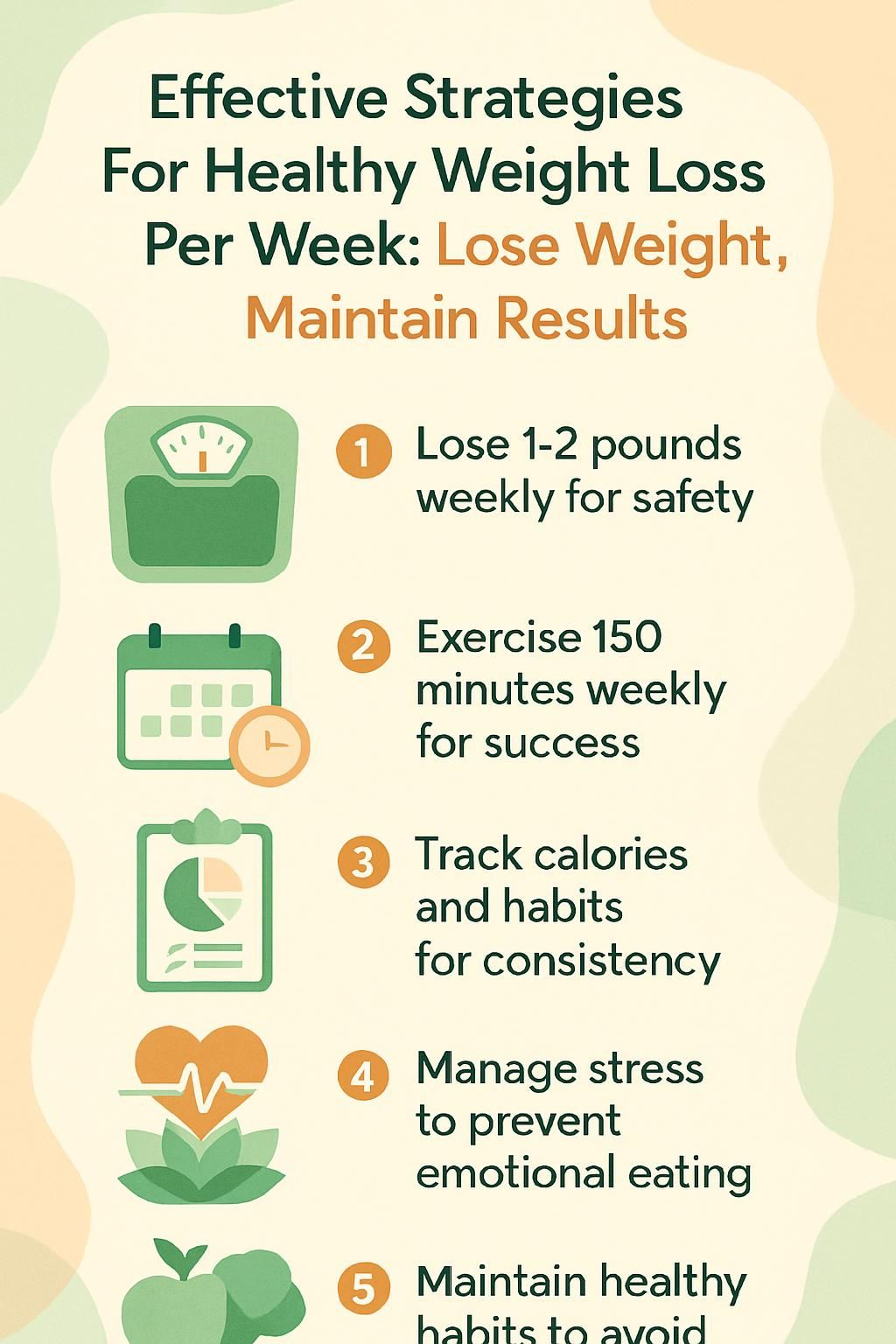Effective Strategies For Healthy Weight Loss Per Week: Lose Weight, Maintain Results
Our Nutrition Assistant AI Suite will transform your body. You will lose fat, get toned, and build muscle. Gain confidence and optimal health.
Keeping weight off week after week is hard, especially with busy schedules and stress. Healthy weight loss means aiming for 1 to 2 pounds per week. This steady pace improves your odds of long-term success and lowers risks like high blood pressure and type 2 diabetes. You will learn simple steps to lose weight, maintain results, and build habits that last using healthy eating, physical activity, sleep, and stress control.
Key Takeaways
- Most experts, including the CDC, suggest losing 1 to 2 pounds per week for safe, lasting progress.[1]
- Pair a balanced diet that is rich in protein and fiber with at least 150 minutes of moderate exercise weekly to support weight loss and heart health.
- Food logs and tracking apps help many people maintain long-term weight loss by monitoring calories, steps, sleep, and stress.
- Stress management, like counseling or support groups, reduces emotional eating that can lead to regaining weight.
- Consistent habits, such as daily breakfast, self-monitoring, and regular physical activity, help prevent weight regain after you reach your goal.

Emphasize the importance of healthy, sustainable weight loss
Slow and steady weight loss, about 1 to 2 pounds per week, supports better health and makes maintenance easier. The Centers for Disease Control and Prevention notes that people who lose weight at this pace with healthy eating and regular physical activity are more likely to keep it off.
Quick fixes and rapid weight loss plans often cause rebound weight gain. That swing can strain your body and mood. Building small daily habits works better than short-term diets.
After I swapped sugary drinks for water and walked five days a week, I lost almost 10 pounds. The best part was how routine it felt within a month.
Healthy living is not about being perfect; it is about making better choices most of the time.
Mention the challenges of maintaining weight loss over time
Many people regain weight within a few years, as shown by the National Weight Control Registry. Your body may push back by slowing metabolism and raising appetite after weight loss.
Sticking with new habits helps. Plan regular meals, include breakfast, and keep moving most days. A structured weight management program or working with a registered dietitian can improve long-term results.
Expect setbacks. If you regain some weight, restart your plan and adjust. Evidence supports ongoing calorie control, lower fat intake, and physical activity at least 5 days a week for long-term weight control.
Understanding Healthy Weight Loss

You can aim for a healthy rate of 1 to 2 pounds per week through diet and exercise. The steps below show how to build a plan that supports long-term weight management without burning out.
Defining a healthy rate of weight loss (1-2 pounds per week)
Losing 1 to 2 pounds per week is considered the safest rate for most adults. This approach helps you lose adipose tissue, which means body fat, while protecting muscle and metabolism. Many people reach this pace by eating 500 to 750 fewer calories per day and increasing activity.
Steady weight loss can improve blood sugar and cholesterol. Medications, stress, medical conditions like hypertension or prediabetes, and age can change your rate of loss.
During my own plan last year, a gradual pace helped me keep energy while I built better eating habits.
A reasonable amount of weight loss often means big improvements in cardiovascular disease risk factors.
Importance of setting realistic goals
Realistic goals keep you focused and safe. Many health agencies, including the CDC, suggest 1 to 2 pounds per week. Use both action goals and outcome goals.
- Action goals: walk 30 minutes daily, cook dinner at home 5 nights a week.
- Outcome goals: lose 10 pounds over several weeks, reduce waist size by 2 inches.
Small wins add up and reduce frustration. Even a 5 percent drop in body weight can improve heart health and type 2 diabetes risk. Once your goals are set, build a balanced diet plan to support them.
Creating a Balanced Diet Plan
A balanced diet that is low in calories and high in nutrients helps you lose weight and keep it off. The tips below show you what to eat, how much to eat, and how to stay satisfied.
Importance of macronutrients (proteins, fats, carbohydrates)
Proteins, fats, and carbohydrates are macronutrients. They give energy and support weight loss when balanced well.
- Protein: found in lean meats, eggs, dairy, tofu, and beans. It helps you keep muscle and feel full longer.
- Healthy fats: found in olive oil, nuts, seeds, and avocado. They support brain and heart health. Choose unsaturated fats over saturated fats to improve cholesterol.
- Carbohydrates: pick whole grains, vegetables, and whole fruits. These choices provide steady energy and fiber.
Fill half your plate with non-starchy vegetables, one quarter with lean protein, and one quarter with whole grains like brown rice or quinoa. If you have medical conditions such as high cholesterol or diabetes, consult a Registered Dietitian Nutritionist for a plan that fits your needs.
Incorporating whole foods and reducing processed foods
Choose whole foods most of the time. Fruits, vegetables, beans, and whole grains provide fiber that supports fullness and stable blood sugar.
- Swap white bread and pasta for whole wheat bread, oats, or brown rice.
- Choose fresh snacks like berries, carrots with hummus, or a handful of nuts.
- Limit ultra-processed foods high in added sugar, sodium, and unhealthy fats.
These swaps can improve low-density lipoprotein, the bad cholesterol, and support physical fitness. Next, keep portions in check and add mindful eating to your routine.
Portion control and mindful eating strategies
Portion sizes can sneak up on you. Use smaller plates and bowls to lower calories without feeling deprived. The American Heart Association notes that portion control can cut hundreds of daily calories.
- Eat without screens. Focus on the flavors and textures of your meal.
- Take small bites and chew slowly for at least 20 minutes per meal.
- Limit added sugars. Enjoy whole fruit for sweetness.
- Measure common items for a week to reset your eye for portions.
Mindful eating plus portion control supports weight loss and makes meals more enjoyable. You will feel more satisfied and less guilty about your choices.
Incorporating Physical Activity
Exercise helps your body burn calories and improves mood. Think of movement as a daily tool, not a punishment.
Recommended types of exercise (aerobic, strength training, flexibility)
Aim for at least 30 minutes of aerobic activity most days. Brisk walking, cycling, or swimming raises your heart rate and boosts calorie burn. These activities can also raise high-density lipoprotein, known as good cholesterol.
Add strength training two days per week to build muscle. Muscle tissue burns more energy, even at rest. Simple options include bodyweight moves, resistance bands, or free weights.
Include flexibility work like yoga or stretching. It lowers injury risk and keeps you moving. If you follow a plant-based diet or had bariatric surgery, talk with your healthcare provider before you change your routine.
Creating a balanced workout routine
Blend cardio, strength, and flexibility into your week. Many experts recommend at least 150 minutes of moderate cardio plus two strength sessions.
- Walk briskly 30 minutes, five days a week.
- Do two strength workouts focused on major muscle groups.
- Stretch for 5 to 10 minutes after workouts.
Add movement breaks to your day. Take stairs, park farther away, or stand during calls. Short bursts add up and make weight loss of 0.5 to 1 kilogram per week more likely.
Consistency and enjoyment in exercise
Consistency matters more than perfection. Pick activities you enjoy so workouts feel easier to repeat. Try swimming, hiking, dance, or a beginner class to keep things fresh.
I stayed motivated after I mixed yoga with short jogs across the week. Variety kept me engaged and less likely to skip sessions.
People who move regularly are more likely to keep weight off compared with those who exercise on and off.
Staying Hydrated
Water helps control hunger and supports metabolism. Think of it as a simple tool you can use all day.
Discuss the role of water in weight loss
Drinking water before meals can lower calorie intake because you feel full sooner. Thirst can feel like hunger, which leads to extra snacking. Replacing sugary drinks with water cuts calories and added sugar.
Some studies show that higher daily water intake supports greater weight loss. Your body also needs water to break down fat and remove waste through urine and sweat. Aim for at least eight cups daily, more if you exercise or live in a hot climate.
Tips for increasing water intake
Carry a reusable bottle and sip during the day. Set hourly reminders on your phone or watch. Add water-rich foods like watermelon, cucumber, and oranges to meals.
- Drink a glass of water before each meal.
- Keep a simple log to track your intake.
- Add a slice of lemon or mint for flavor without sugar.
Ask your healthcare provider for guidance if you have kidney, heart, or endocrine conditions that affect fluids.
Hydration’s impact on metabolism and appetite
Even mild dehydration can slow metabolism and increase cravings. A glass of water before a meal may help you eat less. Good hydration also supports exercise by reducing fatigue.
Set a daily goal, such as eight 8-ounce glasses. Keep a refillable bottle on your desk to make steady sipping simple. You might notice better focus and more even energy within a week.
Mindful Eating Practices
Mindful eating teaches you to notice hunger and fullness cues. It also helps you enjoy food more while eating less.
Techniques for practicing mindfulness during meals
Turn off screens at mealtime. Look at your food’s colors, notice the aroma, and pay attention to texture. Chew slowly and pause between bites by setting your fork down.
These steps give your brain time to signal fullness, which usually takes about 20 minutes. The result is fewer calories eaten and more satisfaction.
Recognizing hunger and fullness cues
Ask yourself how hungry you are before eating, then check in halfway through the meal. Research suggests that paying attention to these signals can lower calorie intake.
During my mindful eating practice, slowing down helped me enjoy meals and cut back on automatic snacking after work.
Stopping when satisfied, not stuffed, is a skill. Practice builds confidence and control.
Benefits of slowing down while eating
Eating slowly helps you notice fullness, which reduces overeating. Many people find that they eat fewer calories yet feel more satisfied.
Focus on your plate without distractions. Over time, this calm approach supports steady weight loss and a healthier relationship with food.
Tracking Progress and Adjusting Goals
Tracking gives you a clear picture of your habits. Adjusting your plan keeps progress moving when life changes.
Importance of keeping a food diary or using apps
Logging meals shows what, when, and how much you eat. People who track food and activity tend to lose more weight and keep it off longer. Many successful maintainers report watching their nutrition, steps, sleep, and stress.
Apps such as MyFitnessPal or Lose It! make logging fast with barcode scans and charts. They also track workouts. Patterns stand out, like late-day snacking or weekend splurges. Seeing your choices helps you set better goals and celebrate wins.
Setting milestones and celebrating small victories
Create weekly targets like 1 to 2 pounds lost, more daily steps, or three home-cooked dinners. Use non-food rewards when you hit milestones.
- Fresh flowers for your desk.
- A new playlist for workouts.
- Time outside at a local park.
Positive rewards build momentum and make healthy habits feel good to repeat.
Adjusting strategies based on progress
If your weight stalls for two weeks, review calories, portions, and activity. Small tweaks often restart progress, like adding a walk after dinner or pre-portioning snacks.
Once you hit a goal, set the next one. For example, raise steps from 5,000 to 7,000 per day or add a second strength day. I noticed holiday portions creeping up last year, so I prepped meals ahead and got back on track.
Adjustments keep the plan fresh and prevent boredom.
Stress and Emotional Health
Stress can slow weight loss and push you toward comfort foods. Strong emotional health supports steady progress.
How stress can affect weight loss
Stress raises cortisol, a hormone that ramps up cravings for sugary or fatty foods. Long work hours and poor sleep increase snacking and reduce the desire to exercise. Research links these patterns to weight gain over time.
Stress also disrupts hunger hormones, which makes fullness harder to sense. If stress feels heavy, seek help. Brief counseling can teach coping skills that replace emotional eating.
During tight deadlines, my habits slipped until I learned simple breathing exercises and spoke with a counselor about triggers.
Strategies for coping with stress without turning to food
Create a short list of stress resets. Try deep breathing, a 10-minute walk, music, or journaling. Use these tools at the first sign of tension.
- Schedule a friend check-in once a week.
- Keep a stress log to see what helps most.
- Set bedtime alarms to protect sleep.
These steps support your goals and prevent automatic snacking.
Considering professional help for mental health
Therapists and counselors use proven methods to manage stress, low mood, and anxiety. Many people find that even short-term support improves eating habits and follow-through on exercise.
If you notice ongoing sadness, worry, or sleep problems, talk with a healthcare professional. Early support can make weight loss plans easier to follow.
Building a Support System
A strong support system brings encouragement and accountability. It can make tough weeks feel manageable.
Benefits of having a support system (friends, family, groups)
Support from friends, family, or groups improves your chances of losing weight and maintaining results. Check-ins add accountability, and shared activities make healthy choices easier.
Sharing progress in a journal or app keeps goals clear. Weekly check-ins with coworkers helped me stay consistent without feeling alone.
Exploring weight loss communities online and offline
Online forums and social groups offer practical tips and motivation. Offline, local fitness classes and community programs provide structure and connection.
People in groups often stick with healthy habits longer than those working alone. If you need extra help, ask a nutritionist or trainer to guide you.
Seeking professional help (nutritionists, personal trainers)
A Registered Dietitian Nutritionist can tailor a plan to your health needs, including diabetes or high cholesterol. Regular follow-ups help you adjust as your body changes.
Personal trainers build safe, effective workouts for your fitness level. They help you progress and avoid injury. Expert feedback keeps you accountable and motivated week after week.
Maintaining Long-Term Weight Loss
Healthy weight loss becomes easier to maintain when you build routines that stick. Think of maintenance as daily practice, not a finish line.
Strategies for sustaining weight loss after reaching goals
Keep the habits that helped you lose weight. The National Weight Control Registry reports that successful maintainers often continue reduced calorie and fat intake, eat breakfast daily, weigh weekly, and follow consistent meal patterns.
Self-monitoring helps you catch small slips early. Aim for at least 150 minutes of moderate exercise each week, such as brisk walking or cycling. If stress prompts overeating, use your coping skills or seek support to stay on track.
Importance of consistent healthy habits
Regular meals, including breakfast, help steady hunger and energy. People who eat a balanced breakfast tend to keep weight off better over time.
Daily walks, drinking water instead of sugary drinks, and mindful eating protect your progress. Sustainable changes beat quick fixes for long-term health.
Overcoming setbacks and staying motivated
Small slips happen. If you miss a workout or overeat, reset at the next meal or the next day. Quick course corrections prevent larger regains.
Treat setbacks as information. Use support from friends or a group when motivation dips. Consistent action leads to lasting results.
Conclusion
Healthy weight loss per week works best with simple, steady habits. Focus on whole foods, portion control, regular physical activity, and stress management. Set clear goals, track your progress, and make small adjustments as needed.
Even modest changes can improve blood pressure and cholesterol.[1] This article is educational, not medical advice. If you have health conditions or take prescription medications, consult your healthcare provider before making major diet or exercise changes.
Building solid habits today helps you lose weight and maintain results for years.
…
[1] Centers for Disease Control and Prevention. (2022). Losing Weight: Getting Started. https://www.cdc.gov/healthyweight/losing_weight/index.html.
FAQs
1. How much weight can a person safely lose in one week using evidence-based strategies?
Most health experts recommend losing 1 to 2 pounds per week for lasting results. This rate helps protect muscle mass and supports long-term success, as shown in studies from the Centers for Disease Control and Prevention.
2. What are effective methods to achieve healthy weekly weight loss?
Effective approaches include tracking calorie intake, increasing physical activity, choosing nutrient-rich foods like vegetables and lean proteins, and setting realistic goals. Research shows that combining these habits leads to steady progress.
3. Why is it important to maintain results after reaching a target weight?
Maintaining results prevents regaining lost pounds and supports overall well-being. Studies suggest that ongoing support, regular exercise, meal planning, and self-monitoring help people keep off excess body fat over time.
4. Can personal experience help with staying motivated during weight loss?
Personal stories often inspire others facing similar challenges. For example, keeping a food journal helped me notice patterns in my eating habits; this made it easier to make healthier choices each day.
Summary: Safe weekly weight loss ranges from 1 to 2 pounds when following proven strategies such as balanced nutrition and regular movement. Maintaining new habits is key for lasting change; personal experiences can offer motivation throughout the journey.







